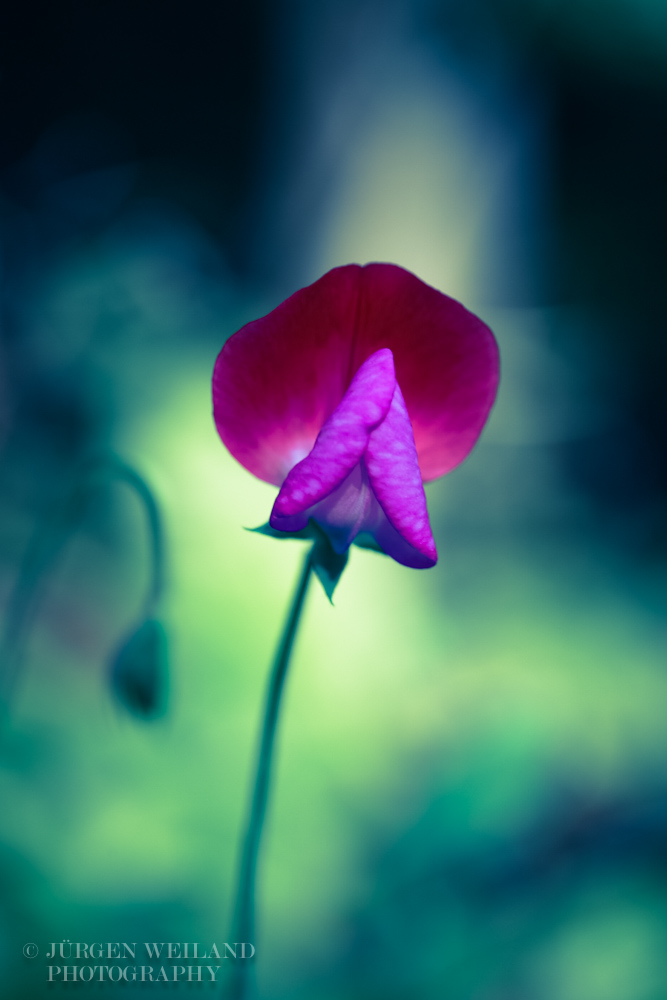Encounters with the Plant Devas - Lathyrus odoratus
29. 08. 15 19:56 filed in:Fabaceae
Last weekend I took some photos of Laythyrus odoratus. She was flowering so beautifully in our home garden and I was aiming to capture one particular blossom in the „right“ light. For that I mostly take photos from different positions, which changes the light and the background. I was also taking images at different times, as the sweet pea looks so different depending on the time of day. When I was later checking the results on my computer, I was deeply touched by the outcome of the images. Especially one image which was reflecting something in the background resembling a special aura. This is something I have not seen before. Did I encounter a Plant Deva??
According to the definition of Thea Summer Deer, Plant Devas are the unseen, other side of nature and they are responsible for keeping everything alive. Without them we could not survive. Although they may go unseen to the untrained eye, devas joyfully appear in their luminous form to the clairvoyant and may even be heard by the clairaudient.
In her publication „Wisdom of the Plant Devas: Herbal Medicine for a New Earth“, Thea gives more explanation about the Plant Devas:
"The word deva is a Sanskrit word meaning „body of light“ or „shining one“. Devas hold all the cellular blueprints and genetic codes for plants in their memories. A plant’s deva can bring even a plant species that has become „extinct“ back into this dimension when a great need for its specific medicine is determined. Every herb, fruit, flower, and vegetable has its own deva, its own identity, and its own character. Devas have been embraced, it seems, by every culture and given many names. The jews called the energy Ruach Elohim; the Egyptians, Gengen Wer; the Persians, Devs; and the Dinka tribe in Africa, Abuk.
Everything we know about medicines we learned in one way or another from plants. No surgery, diagnosis, or remedy would be accomplished without the evolution of knowledge acquired through our relationship with plants. Surgery requires drugs, wich are derived from plants. Diagnosis takes observation, which was practiced by our ancestors in their observation of the natural world.
We are utterly dependent on plants for all of our basic needs - from shelter, fuel, and clothing to medicine and food."
This is particularly true of the pea family, which has a huge economic significance. They produce protein-rich food, fats, wood, paintstuffs, medicines, green manure, ornamental plants, cattle feed, etc. The most common foods used by humans are: lentil (Lens), pea (Pisum), bean (Phaseolus), soy bean (Glycine), peanut (Arachis) and chickpea (Cicer). They are also important suppliers of honey (e.g. clover and acacia) and of liquorice (Glycyrrhiza).
Below you find some images of Lathyrus odoratus, a Sweet Pea which diffuses a beautiful smell (odor).
All images were taken with natural light, no flash has been used.
Feel free to leave you feedback and suggestions below,
Best wishes,
Jürgen

Lathyrus odoratus - Duftwicke - Sweet pea
Follow the link below to find more images:
Fabaceae
According to the definition of Thea Summer Deer, Plant Devas are the unseen, other side of nature and they are responsible for keeping everything alive. Without them we could not survive. Although they may go unseen to the untrained eye, devas joyfully appear in their luminous form to the clairvoyant and may even be heard by the clairaudient.
In her publication „Wisdom of the Plant Devas: Herbal Medicine for a New Earth“, Thea gives more explanation about the Plant Devas:
"The word deva is a Sanskrit word meaning „body of light“ or „shining one“. Devas hold all the cellular blueprints and genetic codes for plants in their memories. A plant’s deva can bring even a plant species that has become „extinct“ back into this dimension when a great need for its specific medicine is determined. Every herb, fruit, flower, and vegetable has its own deva, its own identity, and its own character. Devas have been embraced, it seems, by every culture and given many names. The jews called the energy Ruach Elohim; the Egyptians, Gengen Wer; the Persians, Devs; and the Dinka tribe in Africa, Abuk.
Everything we know about medicines we learned in one way or another from plants. No surgery, diagnosis, or remedy would be accomplished without the evolution of knowledge acquired through our relationship with plants. Surgery requires drugs, wich are derived from plants. Diagnosis takes observation, which was practiced by our ancestors in their observation of the natural world.
We are utterly dependent on plants for all of our basic needs - from shelter, fuel, and clothing to medicine and food."
This is particularly true of the pea family, which has a huge economic significance. They produce protein-rich food, fats, wood, paintstuffs, medicines, green manure, ornamental plants, cattle feed, etc. The most common foods used by humans are: lentil (Lens), pea (Pisum), bean (Phaseolus), soy bean (Glycine), peanut (Arachis) and chickpea (Cicer). They are also important suppliers of honey (e.g. clover and acacia) and of liquorice (Glycyrrhiza).
Below you find some images of Lathyrus odoratus, a Sweet Pea which diffuses a beautiful smell (odor).
All images were taken with natural light, no flash has been used.
Feel free to leave you feedback and suggestions below,
Best wishes,
Jürgen

Lathyrus odoratus - Duftwicke - Sweet pea
Follow the link below to find more images:
Fabaceae
blog comments powered by Disqus